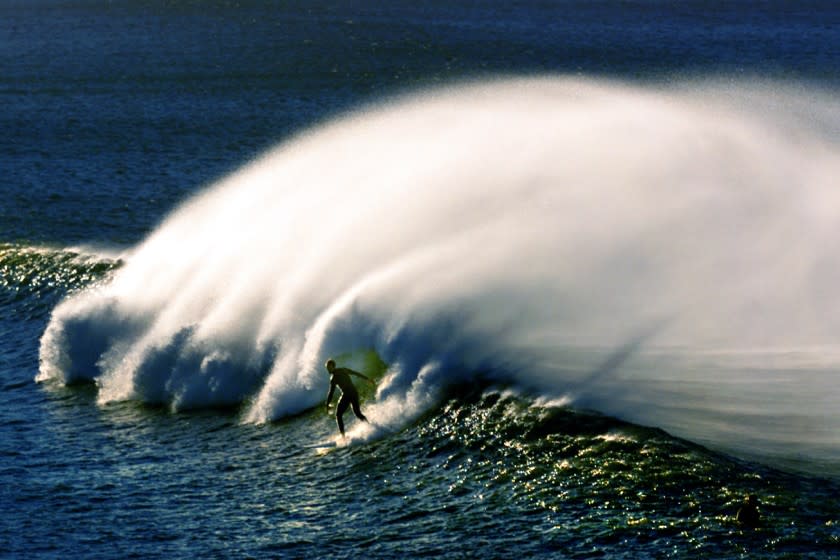Strong, potentially damaging winds possible for L.A. region early next week, forecasters say

Strong, potentially damaging Santa Ana winds are forecast for Southern California from Monday night into Wednesday, the National Weather Service said.
This could result in downed power lines, trees and tree limbs, critical fire danger and a risk for boats moored in east-facing harbors in the Channel Islands.
Santa Ana winds aren't uncommon in January, but the winds predicted next week are particularly perilous because of the scarcity of rain so far this season. The entire state is in drought, according to the latest data from the U.S. Drought Monitor.

Winds could gust from 60 to 80 mph, and possibly higher, the weather service said, with red flag fire conditions almost a certainty, prolonging the recent outbreak of brush fires across Southern California.
"This type of system has some potential to start off with strong north winds before transitioning to a northeast Santa Ana direction," said Eric Boldt, a meteorologist with the National Weather Service in Oxnard. "Some of our strongest Santa Anas do occur in January and we normally don't worry about wildfires much because we've had precipitation and fuels are wet, but not this year for obvious reasons."
Winds are expected to be strong enough to cause turbulent conditions and big waves across the coastal waters and for east-facing harbors such as Avalon and Two Harbors on Catalina Island.
This is partly because this is a fairly cold Santa Ana, and cold air hugs the ground, so winds can reach all the way out to Catalina, according to David Sweet, a meteorologist with the National Weather Service in Oxnard.
At the same time, high surf from a northwest swell caused by storms in the distant North Pacific will also be in play, with a risk for dangerous rip currents, waves breaking over jetties and large waves at entrances to harbors such as Ventura Harbor.
A cold storm system will move from Utah through Southern California and set up off Baja, ushering cold air into the region. High pressure building into the Great Basin behind the storm system will set up a strong pressure gradient or differential between the high itself and the low-pressure storm system off the Baja coast. This is the recipe for Santa Ana winds. In addition, winds are expected to be strengthened by their alignment with winds in the upper levels of the atmosphere.
Winds are expected to kick up Monday evening, peak Tuesday, then diminish Wednesday morning.
Counterclockwise circulation around the low-pressure system could pull up moisture from the Pacific Ocean off Baja, then interact with the cold air that the system brought in, causing a slight chance of precipitation, particularly in the eastern San Gabriel Mountains, from Monday night until Tuesday evening.
Precipitation has been scarce in much of the Southwest. The U.S. Drought Monitor reports that conditions either didn't improve or, in some cases, areas were already considered to be in exceptional drought, so they "could not be degraded further."
A series of Pacific Storms, including an "exceptional" atmospheric river, have continued to provide the Pacific Northwest with wet weather. In some parts of western Oregon, 125% to 300% of normal precipitation has fallen since the beginning of the year, according to the Drought Monitor.
Stormy, wet conditions in the Pacific Northwest and parched, fire-prone conditions in Southern California and the Southwest are consistent with a La Niña weather pattern. La Niña typically keeps storms to the north, as has been the case for months, with high pressure over the eastern Pacific playing keep-away games with the rain for Southern California. The Southwest has also been set back by a weak monsoon season in 2019 and a no-show monsoon in the summer of 2020.
The National Oceanic and Atmospheric Administration said Thursday that there was a 95% chance that La Niña will persist through the winter, and a 55% chance that the tropical Pacific will return to neutral conditions by spring.
#erbesfire trying to keep it jumping Erbes. Really going good, strong winds pic.twitter.com/hIScV9n9r7
— Michael Coons (@Michael_Coons) January 15, 2021
A La Niña occurs when the sea surface temperatures in the central and eastern equatorial Pacific are below average. Easterly winds over that region strengthen, and rainfall usually decreases over the central and eastern tropical Pacific and increases over the western Pacific, Indonesia and the Philippines.
The outlook for the period beginning Friday favors above-normal precipitation and below-normal temperatures, suggesting a pattern change. Until then, as the Erbes fire has shown, windy, dry conditions will require caution because of severe fire danger.
"The strong interaction between the frigid low pressure streaming out of Canada, with the persistent high-pressure system that has dogged us through the fall and early winter, meets all the requirements for an extreme Santa Ana wind event," said climatologist Bill Patzert. "Given the La Niña-induced drought conditions and the damaging wind gusts forecasted statewide, fire danger is possible from Eureka to San Diego."
"Looking ahead, this dramatic shift in the jet stream will certainly whiplash Southern California out of its summer-like temperatures," said Patzert, "and potentially be a precursor for badly needed rainfall. Better late than never."
This story originally appeared in Los Angeles Times.

 Yahoo Movies
Yahoo Movies 
